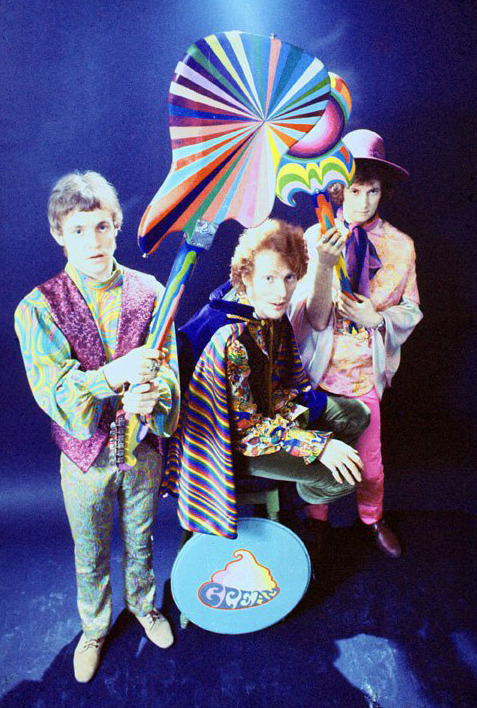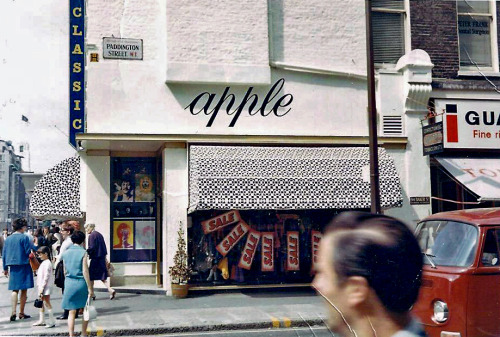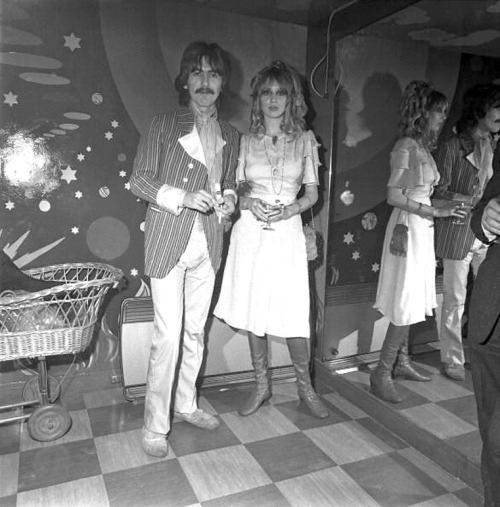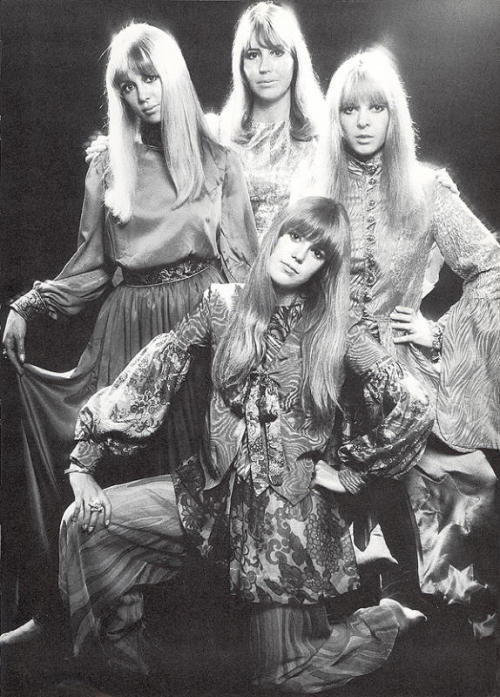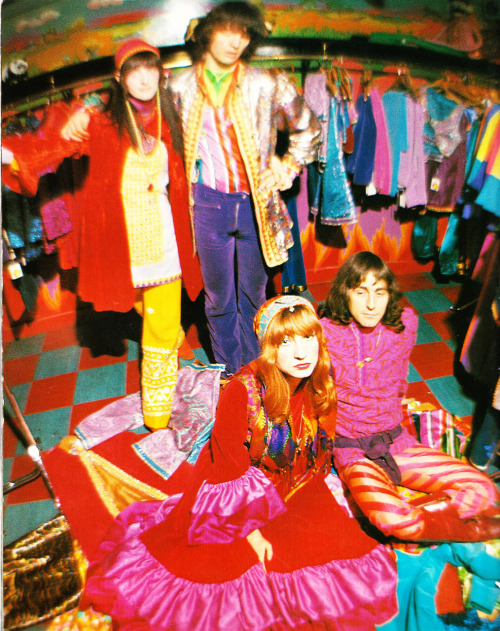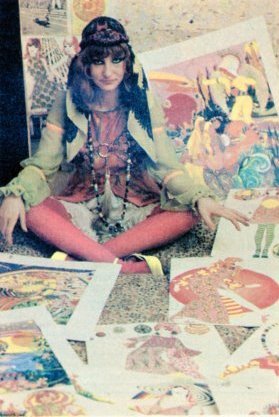The Fool were a Dutch art/design/music collective who had a tremendous impact on London psychedelic scene between 1967 and 1968. Although mostly known for their work with The Beatles, they also designed stage clothes and album covers for Cream, The Move and Incredible String Band. They also designed clothes and interiors for various films and theatre performances and they even recorded an album. The Beatles were such fans of their work, that they left them in charge of their Apple Boutique - with disastrous results.
The Fool consisted of Marijke Koger, Simon Posthuma, Yosha Leeger and Englishman Barry Finch - Leeger's fiancee. Koger was a 'leader' of the group.
Marijke Koger in 1966
Koger, born in 1943, started painting and making her own clothes in her early teens. She dropped out of school at the age of 15, and went to work as a graphic artist at various advertising agencies in Amsterdam. She started her first boutique, The Trend in Amsterdam, at the age of 18 with her friend from school, Yosha Leeger. Around that time, she met Simon Posthuma. Soon after, the three moved , first to Ibiza, and then, after receiving a grant from Von Palland Foundation, to London. The year was 1966. In London, they met Simon Hayes of Mayfair Publicity who took interest in their work, and introduced them to many of his rock star clients. He also brought in Barry Finch as an informal manager. In a short time, The Fool were designing stage clothes for The Hollies and Procol Harum. Later, they were commissioned to design tour program covers and clothes for Cream as well as to customise their instruments.
Cream and their stage gear designed by The Fool, 1967
Pages from program for Cream's first American tour, 1967
Cover for 5000 Spirits or The Layers of Onion by The Incredible String Band, designed by The Fool, 1967
Cover for The Move's album by The Fool, 1967
In 1966, Graham Bond - organist and lead singer of Graham Bond Organisation, introduced Marijke to Tarot, which became an important influnce on her work. It inspired the name for the group, The Fool. Indeed, Tarot, alongside Art Nouveau will prove to be the biggest infuence on The Fool's work (as well as a vast intake of LSD, of course). Meanwhile, the word about The Fool was spreading. Their graphic designs were receiving a lot of attention.
Fashion drawing, 1966
Love Life, Offset poster, 1967
Lucy, Offset poster, 1967
Illustration from a program of Brian Epstein's Saville Theatre, 1967
The illustrations The Fool did for Saville Theatre, which belonged to Beatles manager Brian Epstein, brought them to attention of The Beatles themselves. John Lennon and Paul McCartney came round one evening to Marijke and Simon's place, and were absolutely mesmerised by the psychedelic paintings on their armoire. Soon after, The Fool were commissioned to paint John Lennon's piano..
1967
...and to paint a mural around a fireplace in George Harrison's house, Kinfauns in Esher.
1967
George Harrison's wife, Patti Boyd, and her sister, Jenny were both fans of The Fool and did some modelling for them.
The Fool designed a lot of clothes for The Beatles throughout 1967 , for example, psychedelic tunics they wore for their recording of "All You Need Is Love" for Worldwide Telecast..
In Anthology, Ringo complains that his outfit was so heavy, he could hardly play drums! You can see Marijke and Simon among the crowd. Marijke is actually credited with playing a tambourine on the song.
The Fool also designed clothes The Beatles wore in 'I Am The Walrus' clip in Magical Mystery Tour.
They were also invited to appear in the clip of "A Day In The Life". In fact, they were commissioned to create an inner sleeve for Sgt. Pepper, but their design was not used.
The Beatles were such fans of The Fool's work, that they made them star designers for their new Apple Boutique. The Fool were supposed to design everything - clothes, interior of the shop as well as the exterior.
However, their three-storey psychedelic mural of an Indian goddess proved too distracting for the drivers, and Westminster Council ruled it to be painted over. The Baker Street building was eventually painted plain white. Apple Boutique opened in December 1967. Like everything The Beatles did, the opening was a high profile media event.
The impressively attired gentleman you see at 0.12 is John Crittle, the owner of Dandie Fashions (and future designer for Beatles' Apple Tailoring). He is followed by moustachioed Eric Clapton.
George Harrison and Pattie Boyd at the opening party
Jenny Boyd (bottom) with Beatle wives Pattie Harrison, Cynthia Lennon and Maureen Starr modelling Apple boutique designs, 1968.
George Harrison and Pattie Boyd at the opening party
Jenny Boyd (bottom) with Beatle wives Pattie Harrison, Cynthia Lennon and Maureen Starr modelling Apple boutique designs, 1968.
The clothes designed by The Fool for Apple Boutique were absolutely outlandish and very expensive.
Designs for Apple Boutique, 1968
Costing details from John Lyndon's book detailing all the expenses for various Fool clothing items
Costing details from John Lyndon's book detailing all the expenses for various Fool clothing items
Although the shop had many visitors, people rarely bought anything, treating it more like a tourist attraction. The Fool had very little idea about how to run a business, and the shop started losing money very quickly. Marijke and Simon were using the most expensive fabrics available which made clothes ridiculously expensive.For example, they ordered silk labels for all the clothes. Paul Gorman writes: When the shop's manager - Pete Shotton - a long-term Beatles associate who had been in Lennon's first band, The Quarrymen - pointed out that silk labels would double the price of the clothing, Lennon snapped back, "We're not buisness freaks, We're artists" (Paul Gorman, The Look - Adventures in Rock and Pop Fashion, Adelita edition, 2006, p 46).
One of The Fool's designs and the silk label
Designs for Apple Boutique, 1968
Marijke Koger and Simon Posthuma in Rave magazine, 1968
Marijke Koger and Simon Posthuma in Rave magazine, 1968
Apple Boutique eventually closed down in July 1968 - after merely seven months, during which it had lost nearly £100.000. To maintain the hippie spirit, The Beatles decided to give away all the remaining stock on the last day. As Ringo remembers: We went in the night before and took everything we wanted. We had loads of shirts and jackets - we cleaned a lot of stuff out. It wasn't a sale, we just gave it all away and that was the best idea. Paul adds: The nice thing was that we weren't too fussed when it didn't work out (...) It was great: giving the clothes to people who showed up on the day (he Beatles, Anthology, Cassell & Co, 2000, p 296).
Meanwhile, The Fool moved on to their next project - recording an album. It was produced by their old friend Graham Nash and released in 1968 by Mercury US.
Cover of The Fool's 1968 album
It was an artistic and commercial failure. A&R director at Mercury said: I vomited when the LP was released. It was dreadful and sold about three copies (Gorman, p 47). There is one track on the album - "Rainbow Man" - which stands out, although for all the wrong reasons. It is a blatantly stolen from "Painter Man" by The Creation.
The Fool's involvement in cinema was much more successful , mostly because they were hired to do what they were best at - designing costumes and interiors. The film was called Wonderwall. It was directed by Joe Massott, starring Jane Birkin, Iain Quarrier and Jack McGowran.
Wonderwall brings to mind early movies of Roman Polanski (It was actually scripted by Polanski's former script-writing partner, Gerard Brach; also, Quarrier and McGowran, starred in The Fearless Vampire Killers year earlier), although the horror elements are here replaced by psychedelic weirdness.
Although the script may not be perfect, visually Wonderwall is one of the most stunning films of the 1960's. The Fool's costumes, painted furniture (including the armoire that Lennon and McCartney admired so much) and incorporation of their artwork into the film create unforgettable atmosphere. George Harrison's magnificent score, heavily influenced by Indian music only adds to that effect, making Wonderwall a quintessential Swinging London film, and a compulsory viewing for anybody interested in that era. The film is not as nonsensical as some might think and it contains a lot of interesting nods and references.
Stills from Wonderwall, 1968. The Fool themselves appear in a party scene.
On the set of Wonderwall by Phillippe Le Tellier
Jane Birkin in Wonderwall. Cabinet painted by The Fool can be seen in the background.
On the set of Wonderwall by Phillippe Le Tellier
Jane Birkin in Wonderwall. Cabinet painted by The Fool can be seen in the background.
In 1969, The Fool went to USA to paint murals for Aquarius Theatre in Los Angeles where hippie musical Hair was playing.
At the time, it was the largest outdoor mural in the world (evidently ,the authorities in L.A. were more tolerant than Westminster Council).
Soon after, The Fool split up. In the 1970's Marijke Koger went into designing fabric for department stores. She also created a line of rainbow and clound - inspired outfits called Astraflash.Today, she resides in California. Simon Posthuma also lives there, and reportedly he has been writing an autobiography titled A Fool Such As I.
Raquel Welch modelling Marijke Koger's post-Fool design, 1971.
To those who wish to find out more about the story of Apple, I recommend a book The Last Cocktail Party by Richard DeLillo.
Bibliography and Images
To those who wish to find out more about the story of Apple, I recommend a book The Last Cocktail Party by Richard DeLillo.
Bibliography and Images
Dan Nadel, Norman Hathaway, Electric Banana : Masters of Psychedelic Art, 2012
Paul Gorman, The Look - Adventures in Rock and Pop Fashion, Adelita edition, 2006
Paolo Hewitt, Fab Gear - The Beatles And Fashion, Prestel, 2011
Paolo Hewitt, Fab Gear - The Beatles And Fashion, Prestel, 2011





